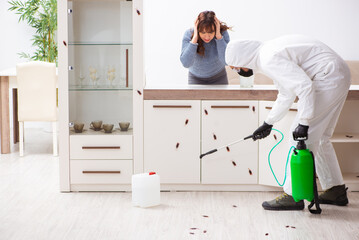The first step in pest control is to identify the pest and determine whether it is causing damage. This will help you decide whether to take action, such as applying a pesticide.
Maintaining clean areas prevents pests from hiding and breeding. It also keeps them from gaining access to your food. Contact Pest Control Bridgewater NJ for professional help.
In order to control pests, it is important to first identify them. This is true whether you are dealing with pests in a home, an equine facility, a garden landscape or in agricultural settings. A number of methods can be used to identify pests including visual inspection, examining a sample, and using laboratory identification techniques.
Many pests are difficult to distinguish from non-pests, particularly as they go through their life cycles. For example, an immature beetle may look similar to a caterpillar or worm. Also, some pests have similar habits and appearance to beneficial organisms, making them easy to confuse with non-pests or with plants that are not a threat. Incorrect identification can lead to misapplication of pest control products. It can also result in the use of an incorrect treatment method, which can make a pest problem worse.
Some pests are harmful to people, animals and property. Examples of these include rodents, cockroaches, and termites. Others are detrimental to the environment such as invasive species and disease-carrying insects. While it is important to take action when a pest becomes an issue, preventing pests is even more effective.
Pest prevention includes limiting the available food, water, shelter and other resources that pests need in order to thrive. In homes, keeping waste and trash in sealed receptacles and cleaning high traffic areas can help prevent pest infestations. It is also important to keep doors and windows tightly closed to restrict pest access. In commercial facilities, securing garbage cans and keeping food in airtight containers can help control pest populations.
While there are a number of pests that can damage crops and structures, most do not cause significant economic or health problems. Therefore, it is not necessary to use pest control measures for every pest detected. Threshold levels have been established for some pests that require immediate action based on esthetic, health, or safety considerations.
Proper identification is key to the success of any pest management program. The USDA National Identification Services provides a wide range of identification and research services for plant pests and beneficial organisms. NIS specialists in the fields of botany, entomology, malacology and mycology serve as the final taxonomic authorities for plant protection and quarantine decisions for the nation’s agricultural and natural resources.
Pest Prevention
Pests invade our homes and buildings seeking food, shelter or warmth, and they can damage property and create health hazards. Practicing pest prevention empowers us to stop infestations at their source, while also keeping our environments healthy and safe for humans and animals alike.
Prevention strategies may include removing attractants such as debris, trash and moisture. Sealing entry points like cracks, crevices and window frames can also be effective, especially if done regularly. Maintaining sanitation and proper garbage disposal practices, including storing garbage in tightly sealed containers, helps to deter pests as well. Regular inspections and monitoring can allow us to quickly spot problem areas and take action before they grow out of control.
Monitoring is a vital component of pest control, regardless of the method being used to address them. This may include logging pest sightings, recording data, or even just reporting on the condition of treated spaces. It is important to understand how each pest population is responding to the environment in which they live, so that we can assess their resiliency and determine whether or not to take control measures.
It is also crucial to know the lifespans and life cycles of the pests in question, as this can help us predict when they will reach threshold levels that warrant action. This information is especially useful when it comes to utilizing non-chemical control methods, which are usually most effective at certain stages of the life cycle or at different times of the year.
Eradication may be the goal of some pest situations, but it is often more practical to focus on suppression and prevention in enclosed environments such as residential and commercial buildings, schools and hospitals, and food processing and preparation facilities. When eradication is the goal, it is usually to reduce the pest population below an acceptable level that will not pose a significant threat to humans or their livestock or pets, as some species of insects, for example, are considered disease vectors and can carry diseases that cause serious illness in human beings.
In order to prevent pests from reaching unacceptable threshold levels, it is essential to establish and adhere to an action plan that includes identifying the most important steps to be taken and when they should be completed. The most effective way to implement this is through integrated pest management (IPM), a sustainable and environmentally conscious approach that prioritizes prevention over treatment.
Pest Control Methods
Often, a pest problem can be controlled without the use of chemicals. When pest control methods are necessary, they should be used in ways that minimize harm to the environment and human health. Prevention is the best approach to pest control, but when pests do occur, a number of cultural, biological, physical and chemical techniques can be employed. These techniques are grouped into an integrated pest management system (IPM) and can be used alone or in combination.
The first step in IPM is to carefully assess the situation and identify the pest. Accurate identification helps determine the cause of the pest infestation and guides management decisions. This information is used to select management practices and evaluate the effectiveness of those practices.
Once the pest is identified, the environmental conditions that promote the pest population should be evaluated. These factors include soil health, nutrient availability, plant growth stages and other biological or ecological conditions that can influence the need for or success of pest controls. Observing the pests’ behavior also provides clues to their identity and the most effective control measures.
A key element of preventive control is removing the food sources that attract and sustain pest populations. In homes, this includes storing food in containers with tight lids and keeping counters and stations clean. In the garden, it means frequent cleaning to remove rotting produce and other attractants.
Biological control methods use natural predators, parasites or pathogens to suppress pest populations. These are a low-risk alternative to chemical controls and can produce long-term results. Examples of these control methods include nematodes to eat aphids, green lacewing larvae to eat ground beetles and minute pirate bugs to eat mites.
Physical and mechanical controls are the next options for controlling pests. These include removing weeds, aerating the soil, and covering the crop with bird netting or other devices to deter pests. Finally, if the problem is severe and other non-chemical controls are not effective, a limited amount of chemical treatment may be needed. Always read product labels and wear personal protective equipment (PPE) when handling any pesticides.
Pesticides
Pesticides are chemicals used to control pests (plant pathogens, insects and weeds). The primary benefits of pesticide use include saving crops, controlling disease vectors that harm humans and livestock and controlling organisms that interfere with human activities and structures. The major disadvantages of pesticide use are that they can cause environmental damage and that some pesticides can be harmful to people.
The term “pesticide” is very broad and encompasses a wide variety of substances, each with its own characteristics and application methods. All pesticides must be registered with the U.S. Environmental Protection Agency before they can be legally sold. The EPA registration process requires that pesticides be thoroughly tested to ensure they are safe for their intended uses. Once a pesticide is registered, the EPA issues a label detailing the legally binding instructions for that pesticide’s use.
All pesticides have some degree of toxicity to humans and animals, but there are many types of pesticides that are considered “low-toxicity” or “lower-risk.” Low-toxicity or low-risk pesticides generally have a lower acute toxicity than high-toxicity pesticides.
Examples of low-toxicity or low-risk pesticides include disinfectants, sanitizers, herbicides and fungicides. Disinfectants and sanitizers kill or inactivate disease-producing microorganisms on inanimate objects, such as tools and buildings. Fungicides kill fungi, including mildews and molds. Fumigants produce gases or vapors to destroy organisms in buildings and soil. Herbicides kill weeds that grow where they are not wanted. Fungicides can be classified as protectants, eradicants or systemics. Protectants prevent disease but cannot eradicate existing infections, while eradicant fungicides kill the fungi on contact and systemics move throughout the plant to prevent the spread of the fungus.
The best way to minimize the risk from pesticides is to employ integrated pest management strategies, such as keeping a garden free of weeds and other unwanted plants. Other prevention techniques can be to keep animals and pets out of gardens, using fences where necessary, and denying pests food, water and places to hide. If a pesticide is necessary, it should be used sparingly, carefully following the label directions. When possible, consider non-chemical alternatives.

